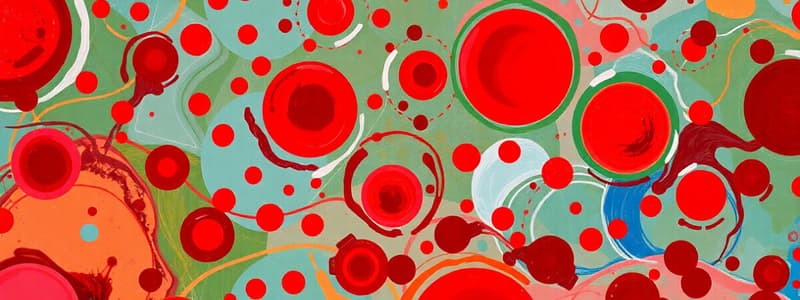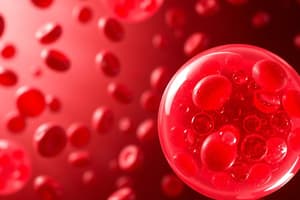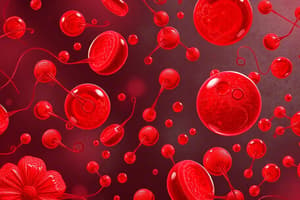Podcast
Questions and Answers
What is the primary role of plasma in blood?
What is the primary role of plasma in blood?
- To facilitate blood clotting
- To transport oxygen to cells
- To carry all blood cells (correct)
- To produce antibodies
Which component makes up the largest percentage of blood volume?
Which component makes up the largest percentage of blood volume?
- Erythrocytes
- Plasma (correct)
- Leukocytes
- Platelets
What is the function of hemoglobin in erythrocytes?
What is the function of hemoglobin in erythrocytes?
- To bind carbohydrates
- To create blood clots
- To carry nutrients
- To transport oxygen (correct)
Which type of blood cells are primarily responsible for immune system responses?
Which type of blood cells are primarily responsible for immune system responses?
What percentage of blood volume do erythrocytes comprise?
What percentage of blood volume do erythrocytes comprise?
What is the role of platelets in the blood?
What is the role of platelets in the blood?
Which type of leukocyte can leave the bloodstream to destroy bacteria?
Which type of leukocyte can leave the bloodstream to destroy bacteria?
What condition results from having too few blood cells or insufficient hemoglobin?
What condition results from having too few blood cells or insufficient hemoglobin?
What is the primary physiological response when the body becomes too warm?
What is the primary physiological response when the body becomes too warm?
Which process occurs to produce heat when the body is too cold?
Which process occurs to produce heat when the body is too cold?
What is the main function of capillaries in the circulatory system?
What is the main function of capillaries in the circulatory system?
What occurs at the arterial end of the capillaries?
What occurs at the arterial end of the capillaries?
What characterizes leukemia, particularly the myeloid type?
What characterizes leukemia, particularly the myeloid type?
How is hemophilia treated?
How is hemophilia treated?
Which of the following is NOT a function of interstitial fluid?
Which of the following is NOT a function of interstitial fluid?
What is a common feature of both types of leukemia?
What is a common feature of both types of leukemia?
Why does blood move slowly through capillaries?
Why does blood move slowly through capillaries?
What happens to blood vessels during vasodilation?
What happens to blood vessels during vasodilation?
Flashcards
Blood as Connective Tissue
Blood as Connective Tissue
Blood connects all parts of the body by transporting materials.
Plasma's Composition
Plasma's Composition
Plasma, the liquid part of blood, contains 55% of blood volume and carries various substances like nutrients, gases, and waste products.
Erythrocytes (Red Blood Cells)
Erythrocytes (Red Blood Cells)
Red blood cells carry oxygen throughout the body. Their structure allows maximal oxygen transport.
Hemoglobin
Hemoglobin
Signup and view all the flashcards
Anemia
Anemia
Signup and view all the flashcards
Leukocytes (White Blood Cells)
Leukocytes (White Blood Cells)
Signup and view all the flashcards
Platelets and Blood Clotting
Platelets and Blood Clotting
Signup and view all the flashcards
Blood's Transport Function
Blood's Transport Function
Signup and view all the flashcards
Homeostasis in Temperature
Homeostasis in Temperature
Signup and view all the flashcards
Vasodilation
Vasodilation
Signup and view all the flashcards
Vasoconstriction
Vasoconstriction
Signup and view all the flashcards
Capillary Surface Area
Capillary Surface Area
Signup and view all the flashcards
Capillary Exchange Function
Capillary Exchange Function
Signup and view all the flashcards
Arteriovenous Shunt
Arteriovenous Shunt
Signup and view all the flashcards
Interstitial Fluid
Interstitial Fluid
Signup and view all the flashcards
Capillary Blood Flow
Capillary Blood Flow
Signup and view all the flashcards
Arterial End of Capillary
Arterial End of Capillary
Signup and view all the flashcards
Hemophilia
Hemophilia
Signup and view all the flashcards
Study Notes
Blood and Circulation
- Blood is a connective tissue, linking all body cells and organs.
- Connective tissue supports and connects different parts of the body (e.g., blood, bones).
Plasma
- Plasma is the liquid component of blood (55% of blood volume).
- Plasma contains fluids, proteins, glucose, gases, wastes, vitamins, and minerals.
- Plasma carries all blood cells.
- Plasma helps transport carbon dioxide (CO2) in the blood.
Remaining Blood Volume
- The remaining 45% of blood volume consists of:
- Erythrocytes (red blood cells): 44% of blood volume
- Leukocytes (white blood cells): 1% of blood volume
- Platelets: Involved in blood clotting.
Erythrocytes (Red Blood Cells)
- Erythrocytes are also known as red blood cells.
- They make up 44% of blood volume.
- They are specially designed to carry oxygen.
- They lack a nucleus.
- Their folded disk shape maximizes surface area to carry more oxygen.
- Packed with hemoglobin, an iron-containing molecule that carries oxygen.
- Anemia occurs when a person has too few red blood cells or too little hemoglobin, reducing oxygen flow.
Leukocytes (White Blood Cells)
- Leukocytes are also known as white blood cells.
- They make up 1% of blood volume.
- They are responsible for immune system responses.
- They contain nuclei.
- Three types of granulocytes: neutrophils, basophils, and eosinophils
- Monocytes can leave the bloodstream to destroy bacteria.
- Lymphocytes produce antibodies to fight pathogens.
Platelets
- Platelets are formed when larger bone marrow cells break apart.
- They do not contain a nucleus.
- They break down quickly in blood.
- They play a key role in blood clotting, preventing excessive blood loss.
Functions of Blood
- Transport: Carries cells and materials (nutrients, waste, hormones).
- Homeostatic Regulation:
- Vasodilation: Body heats up; blood transports heat from respiration and activity to skin; blood vessels widen to increase heat loss. Sweat/Perspiration helps as well.
- Vasoconstriction: Body cools down; blood vessels narrow to reduce heat loss; shivering increases heat production by cellular metabolism.
Circulation and Action of Capillaries
- Combined surface area of capillaries is about 6300 m².
- Capillaries exchange materials between blood and cells.
Capillary Exchange
- Capillaries prevent resource waste when cells don't need servicing.
- They use arteriovenous shunts/sphincters to regulate blood flow.
- Cells are surrounded by interstitial fluid (extracellular fluid).
- Blood moves slowly through capillaries, allowing more time for diffusion.
- Exchange of materials between blood and interstitial fluid happens at the arterial end and midsection of the capillaries.
- Blood is bright red at the arterial end because it's oxygenated.
- Oxygen and nutrients are high in blood but low in tissue fluid/interstitial fluid.
- Diffusion occurs between the blood and tissue fluid.
- At the venous end, osmotic pressure is higher than blood pressure, causing tissue fluid to be reabsorbed and returning to the blood.
Blood Disorders
- Hemophilia: Inherited blood disorder with insufficient clotting protein. Those with severe hemophilia have less than 1% of clotting protein and bleeding can be dangerous. Factor VIII injections can help.
- Leukemia: Cancer of white blood cells. Two types: myeloid (too many immature leukocytes, impairing infection fighting, leading to anemia) and lymphoid (cancer of lymphocytes). Leukemia can be acute or chronic.
Studying That Suits You
Use AI to generate personalized quizzes and flashcards to suit your learning preferences.




